Svanholm Denmark
A working and living community
by Andreas Kamp
The Svanholm community started with an advert in a Danish newspaper on May 7th, 1977, with the title: Large Cohousing. The advert was placed by two families that wanted to start a working and living community in the countryside together with others. The invitation to create a large cohousing community with shared economy, common dining, consensus based decision making, equality between professions, and between women, men, children and adults, created enormous interest, and the first meeting attracted 130 people.
The pioneers purchased and took over the Svanholm Estate on May 31st, 1978. Along with the 800-year-old main building and adjoining houses came over 400 hectares (988 acres) of productive farmland and orest. The original intention of working the land without using pesticides became the starting point for organic farming in Denmark, and since 1990, Svanholm has been completely organic. It is mainly a dairy and vegetable farm, but also has sheep, chickens, pigs and goats. Most land is used for fodder, but also for around 80 vegetable varieties, and berry and fruit orchards. Svanholm has sought a balance between a market-oriented and an ideological farming approach. Recent innovations include holistically-planned grazing, a dedicated vegetarian online shop and an experimental forest garden design in the new permaculture settlements.
Starting out with 150 people and only a few habitable rooms in the former estate owner’s residence was a practical challenge. Much effort has been put into renovating buildings including establishing housing, common areas and other facilities to accommodate everybody. This development has turned the estate into a modern village providing amenities for individuals, community and visitors.
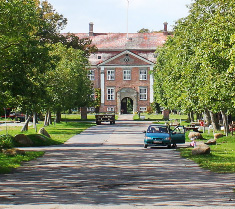
The 800-year old estate main building.
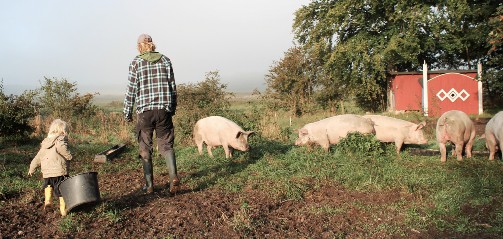
A dozen pigs satisfy Svanholm’s appetite for pork, reduce the amount of kitchen waste and allow for harmonious family pictures.
A holistic life
Svanholm was founded on a dissatisfaction with existing society and the desire to create something new and better. To do that we had to make a fresh start, and so we chose to buy the property. This has given financial restrictions, because of the enormous cost and resulting debt, so we have had to keep our feet on the ground and work hard. Debt or no debt, the people of Svanholm have a large estate of land—a potential paradise, a little enclave—that offers the freedom to try out different strategies for making our dreams come true. Actually, we have developed a kind of state within the State, with our own agreements and ideas. Svanholm has its own internal economic distribution agreements, transition strategy, traffic policy, environmental policy, education policy, health policy and more. In many ways, Svanholm has pioneered developments that have since been implemented in society at large. For instance, we have had different kinds of sabbaticals, long before the politicians in Denmark thought of it. We developed waste sorting systems and worked towards a sustainable way of life, long before the Brundtland report and the introduction of the term ‘sustainability’.
Self government
People don’t move into the Svanholm Collective to join a specific ideology. We share common goals, but there is not a single common political or religious/ spiritual basis that connects us. Our self-government approach is a way of stimulating people to be more involved in decision-making and to feel responsible for the outcome. We wanted and still want direct influence on decisions that concern our own lives. We are aware that majority rule sometimes can be at the expense of the minority. The common meeting, held once a month, is our decision-making body. We never vote, but negotiate to achieve consensus. We have no formal leaders or ‘-isms’, our ambition is to maintain and improve our sense of community and at the same time accept individual differences—to practise equality without uniformity. This provides reassurance and a sense of belonging, and is at the same time a continuous education in compromise, openness, and reflection about personal versus communal needs and desires. It is a guiding principle for social and environmental sustainability to manage our use of resources so that we don’t use more than we give. How to practise this principle, however, is more complicated than agreeing on it! Practising a sustainable lifestyle has required continuous adjustments in the almost 40 years since the founding of the community. However, external reports show that we have high biological diversity and only one third of the CO2 emissions of an average Dane.
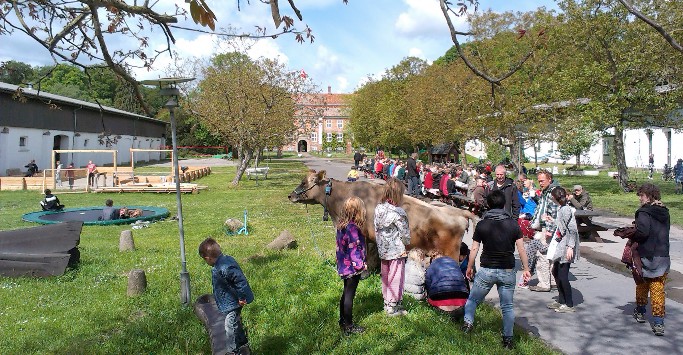
Every year on the 31st of May, Svanholm celebrates its birthday with a communal breakfast under the walnut trees.
Our common economy is a cornerstone in our attempt to maintain social sustainability. It allows us to give priority to employment in the community’s kitchen, administration, maintenance group and farming and self-sufficiency activities. The increased amount of free time this gives is very attractive to people who want an alternative to the 40 hours of paid work a week, plus 20-30 hours of household chores, of a typical Danish adult. There are many ideological, ecological and economic reasons for using Svanholm’s natural resources to support self-sufficiency. The food such as vegetables, meat, dairy products and eggs that the farm supplies, in addition to what is sold, contribute about half of the community’s diet. This balances the desire for homegrown food with the desire for a varied diet. Since the late eighties, two wind turbines produce enough power to cover the community’s needs. We heat our buildings with wood chips from our forest and have our own water supply and sewage treatment system. Regarding self-sufficiency, there are, however, still significant gaps to close with respect to animal feed, fertilizer, transport fuels and a popular diet. We have realized that our self-sufficiency initiatives must proceed at a pace that is compatible with developments around us in order to be successful.
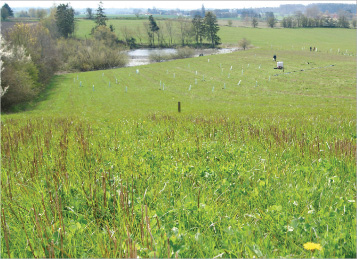
Establishment of the first permaculture settlement at Svanholm in 2016—view to the south.
Location: 50 km west of Copenhagen, Denmark.
Established: 1978
Area: 400 ha (1000 ac). Half of it farmland, the rest woods and park/ garden.
Population: 80 adults and 55 children
Housing: 6200 m2 (66736 ft2), 14000 m2 (151000 ft2) farm buildings.
Common facilities: Power, heat and water supply. Dining hall, large kitchen, ball room, playgrounds, forests and lakes, e-bikes and cars.
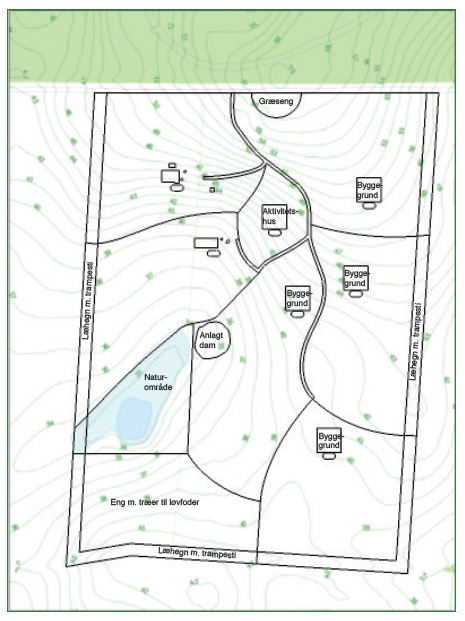
Map of the six farms planned in the permaculture settlement.
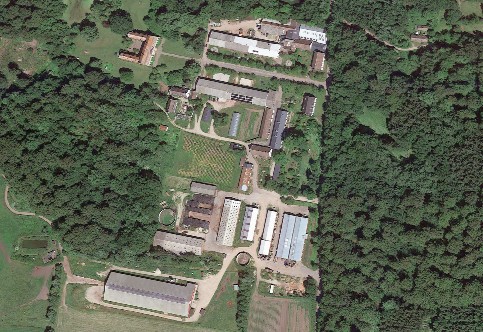
Aerial photo of the estate’s buildings.
The Permaculture Farms at Svanholm
by Esben Schultz & Mira Illeris
In 2016, a group at Svanholm started establishing the first two permaculture farms there. Two young families with children are starting up the project. Each farm is 1.5 ha. The full project is expected to be six farms on 11 ha of land. The farms are on farmland that the project rents from the Svanholm community. The area is on a south sloping hill near the forest at Svanholm. The new farms are converting fields into forest gardens or agroforestry, and are designed to support an almost entirely self-sufficient lifestyle.
The Svanholm permaculture project is remarkable in the sense that the municipality has given it dispensation from relatively strict zoning rules. The reason for allowing the experiment is that it demonstrates environmentally correct farming practices, including high levels of self-sufficiency and biodiversity, independence from fossil fuels, minimal CO2 emissions and carbon storage. The families will have to meet 75% of their household needs from a land-based livelihood, with no fossil fuels used after establishing the project.
The farmhouses will be small, one-storey buildings, built mainly with local materials like timber, straw bales, clay and stones, and will have green roofs. It is possible to volunteer at Svanholm and in the establishment of the permaculture settlement.
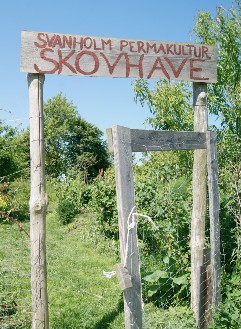
An existing forest garden used for teaching.
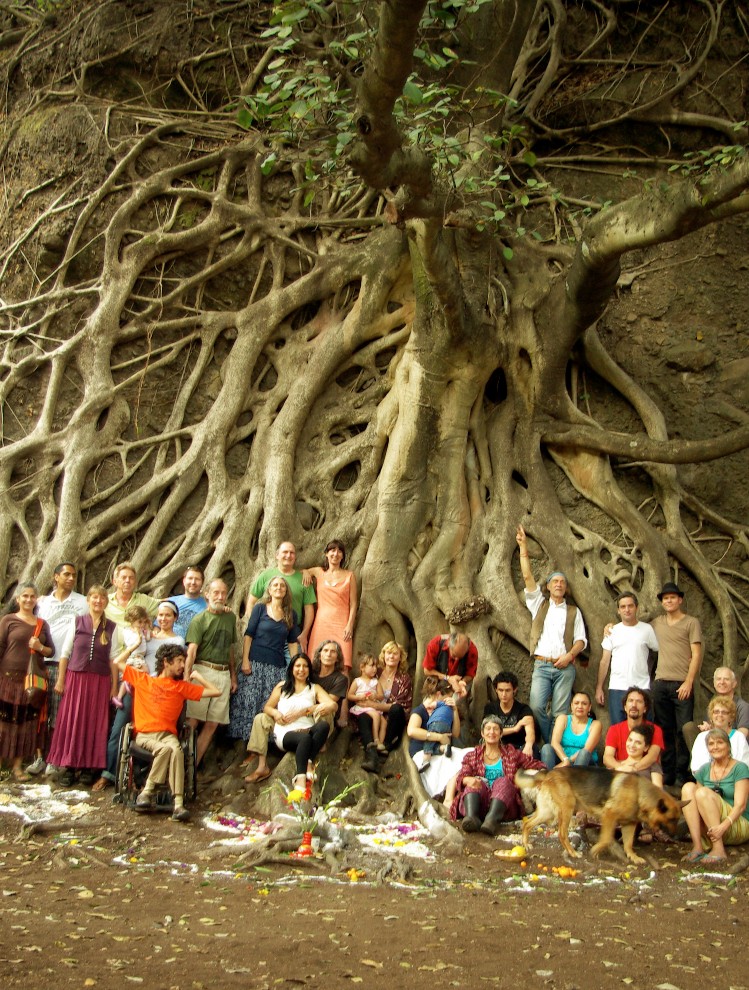
Huehue Family and the Sacred Amate Tree.